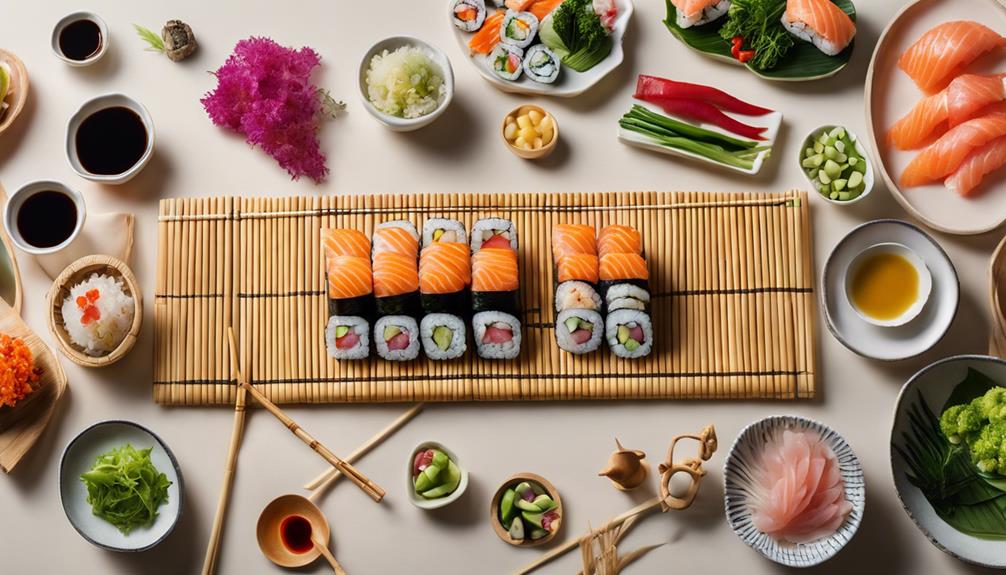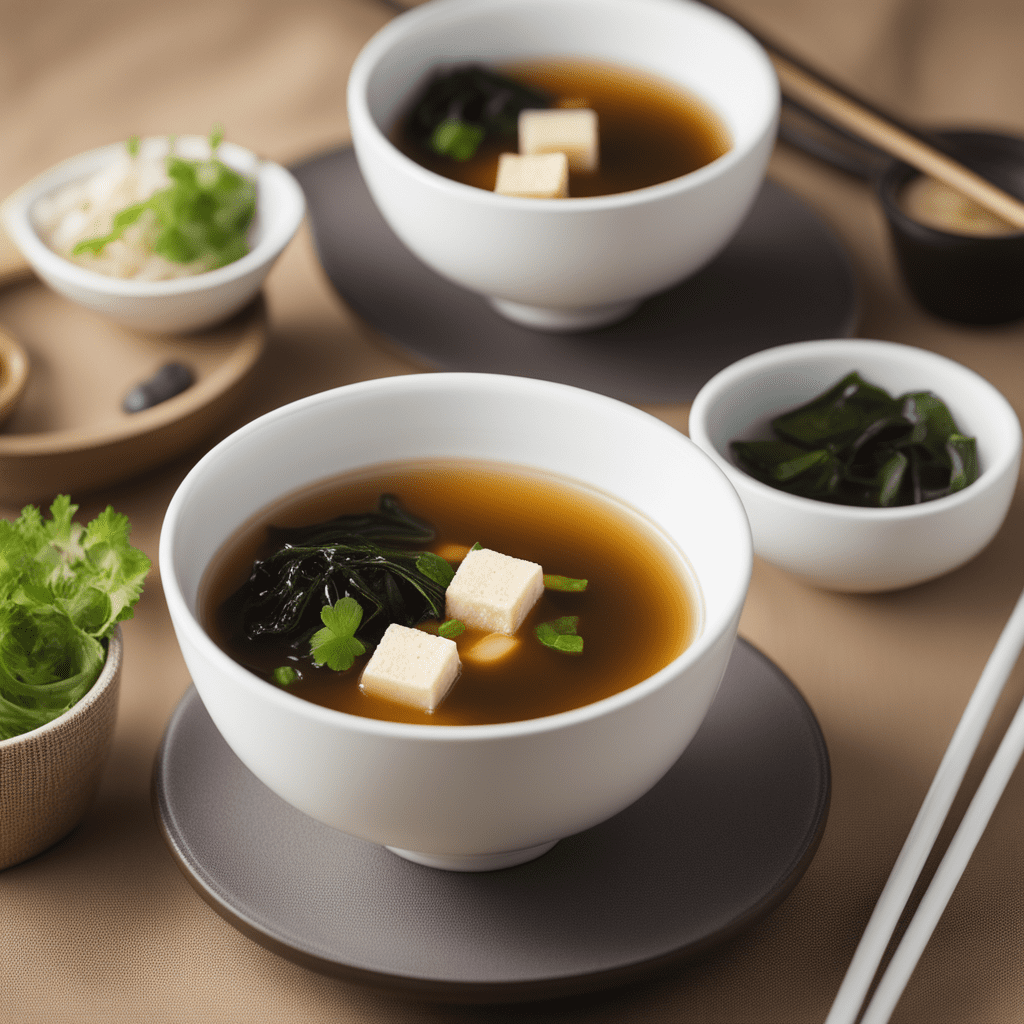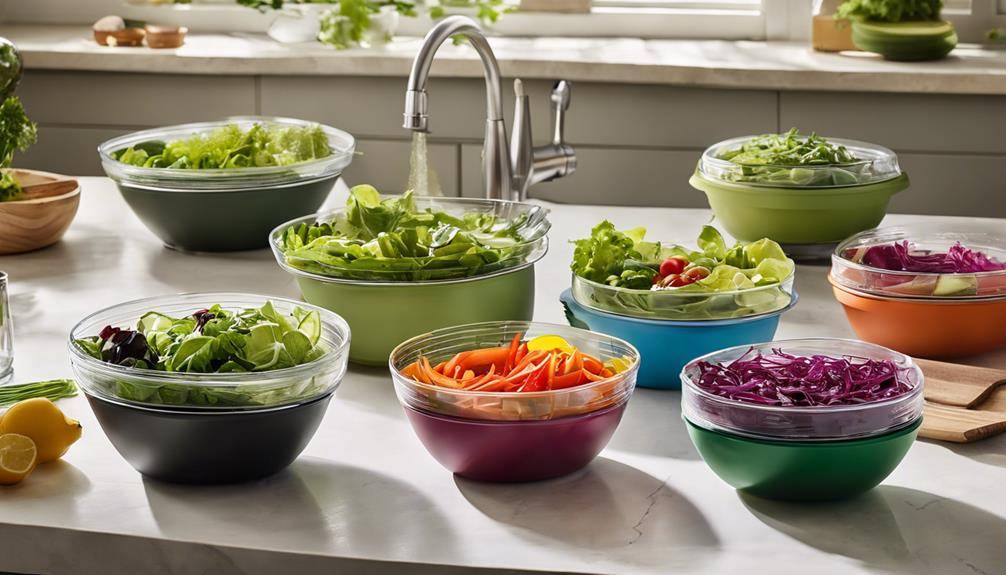How To: Nine Essential Tips For Traditional Sushi Rolling

Essential Tips For Traditional Sushi Rolling; To master traditional sushi rolling, start by choosing high-quality, fresh ingredients. Prepare your sushi rice properly by rinsing and seasoning it well. Use the right tools, like a bamboo mat and a sharp knife, to create clean rolls. Practice your rolling technique, applying gentle pressure while keeping the fillings balanced. Focus on creative plating and enjoy the process, inviting friends to join in. Don’t forget to pair your sushi with sauces that enhance the flavors. Each step adds to the experience, and there’s more to explore that can elevate your sushi skills even further.
Choose Quality Ingredients
When you’re making sushi, the quality of your ingredients can make or break the dish. Start by focusing on sourcing fish that’s not only fresh but also sustainable. Look for seafood that’s been responsibly caught or farmed; this guarantees a better impact on the environment and supports local fishing communities. Local markets often have the best selections, so check them out for freshly caught fish and seafood options.
Next, consider the vegetables. Opt for organic vegetables when possible; they’ve got a more vibrant flavor and are typically free from harmful pesticides. Seasonal selections can also elevate your sushi, adding unique flavors and textures that change throughout the year. For instance, using ripe avocados in summer or earthy root vegetables in fall can enhance your rolls.
Don’t overlook rice varieties either. Different types of sushi rice can impact the texture and flavor profiles of your rolls. Short-grain rice is classic for sushi, but experimenting with other varieties can lead to exciting new tastes.
Ultimately, ingredient freshness is key. Fresh ingredients not only taste better but also contribute to the overall aesthetic of your sushi. When you combine high-quality fish, organic vegetables, and the right rice, you create a harmonious dish that showcases the beauty of sushi-making. So, take the time to choose your ingredients wisely, and you’ll be well on your way to creating sushi that impresses.
Prepare Sushi Rice Properly
After selecting high-quality ingredients, the next step in crafting perfect sushi is preparing the rice properly. The foundation of great sushi lies in the rice, so understanding the different sushi rice types is essential. You’ll typically use short-grain or medium-grain rice, as these varieties provide the sticky texture that holds your sushi together.
Start by rinsing the rice thoroughly under cold water until the water runs clear. This removes excess starch and prevents your sushi from becoming gummy. Once rinsed, soak the rice in water for about 30 minutes to allow it to absorb moisture. After soaking, drain the rice and combine it with the appropriate amount of water in a rice cooker or pot. A good rule of thumb is to use a 1:1 ratio of rice to water, but this can vary depending on the specific rice type.
Once the rice is cooked, it’s time to season it. While there are various seasoning techniques, the classic approach involves combining rice vinegar, sugar, and salt to create a balanced flavor. Heat these ingredients together until the sugar dissolves, then gently fold the mixture into the cooked rice. Be careful not to mash the grains; you want to maintain their integrity.
Let the seasoned rice cool to room temperature before using it to roll your sushi. Properly prepared sushi rice enhances the overall flavor and texture of your rolls, ensuring a delicious end result.
Use the Right Tools
Using the right tools is essential for rolling sushi effectively. To achieve the perfect roll, you’ll need a few key instruments that will make your sushi-making experience smoother and more enjoyable. First and foremost, invest in a high-quality sushi knife. A sharp, well-balanced knife is imperative for cutting through the rice and fillings without squishing them. It allows you to achieve clean cuts, which is fundamental for presentation. If you’re using a dull knife, you’ll struggle with your rolling techniques and end up with a messy result.
Next, consider having a good pair of scissors handy. They’re great for trimming nori and adjusting the size of your rolls if needed. While many people focus on the knife, having scissors can make your rolling process more efficient, especially when you’re working with delicate ingredients.
Additionally, having a bowl of water nearby can help you keep your fingers moist while handling sushi rice. This prevents the rice from sticking to your hands and makes the rolling process much easier.
Lastly, don’t forget about a clean cutting board or surface. A stable, flat area will help you execute your rolling techniques more effectively and maintain control over your ingredients. With the right tools at your disposal, you’ll be well on your way to mastering the art of sushi rolling, ensuring that each roll is a delicious and visually appealing creation.
Master the Bamboo Mat
To roll sushi like a pro, mastering your bamboo mat is essential. Start by choosing the right mat for your needs and guarantee it’s properly aligned for the best results. Don’t forget to clean and maintain it to keep your sushi-making experience enjoyable and hygienic.
Choosing the Right Mat
Mastering the art of sushi rolling hinges greatly on your choice of mat, and the bamboo mat stands out as the preferred tool for both beginners and seasoned chefs. When selecting a sushi mat, consider the various sushi mat types available. Bamboo mats are popular due to their flexibility and durability, but you might also find silicone mats as practical alternatives.
Think about mat material options that suit your needs; bamboo offers traditional appeal, while silicone mats are non-stick and easier to clean. Pay attention to mat size considerations, as a standard 9″x9″ mat is ideal for most rolls, but larger mats are available for bigger creations.
When it comes to mat care techniques, remember to clean your mat immediately after use. Use gentle cleaning methods, avoiding harsh chemicals. For storage solutions, keep your mat flat or rolled loosely to maintain its shape and longevity. Follow mat usage tips, like applying a light layer of plastic wrap to prevent sticking and enhance your rolling experience. By understanding mat durability factors and applying effective mat selection criteria, you’ll enjoy a successful sushi rolling journey.
Proper Mat Alignment
Achieving the perfect sushi roll starts with proper mat alignment. You want to make sure your bamboo mat is positioned correctly to facilitate a smooth rolling process. Lay your mat out horizontally, with the slats running parallel to your body. This mat orientation helps you exert even rolling pressure throughout the sushi roll, ensuring a tight and uniform finish.
As you prepare to roll, place your nori sheet on the mat, leaving a small edge to seal the roll later. When you add your fillings, distribute them evenly along the center of the nori. This will help maintain balance and shape as you start to roll. When you begin the rolling motion, use your fingers to guide the ingredients while applying firm but gentle rolling pressure. This technique will help compress the fillings and prevent them from spilling out.
Keep your hands steady and focus on the alignment of the mat and nori as you roll. A well-aligned mat combined with the right pressure will make it easier to create perfectly shaped sushi that looks as good as it tastes. Now, you’re ready to roll!
Cleaning and Maintenance Tips
After rolling your sushi, it’s important to give your bamboo mat some care to keep it in top shape. First, rinse your mat under warm water to remove any rice or food particles. Avoid using soap, as it can seep into the bamboo and affect the flavor of your sushi. Instead, focus on gentle scrubbing with a soft sponge or cloth to maintain its integrity.
Next, make sure to dry your mat thoroughly after washing. Lay it flat or hang it up to air dry completely. This step is essential for preventing mold and bacteria growth, keeping your sushi equipment in line with proper sanitation practices.
For long-term equipment care, store your bamboo mat in a cool, dry place. Avoid direct sunlight, which can warp the bamboo over time. If you notice any persistent odors, consider soaking your mat in a mixture of water and vinegar, then rinse and dry again.
Practice Your Rolling Technique
To perfect your sushi rolls, it’s crucial to use quality ingredients that enhance flavor and texture. You’ve already mastered the bamboo mat, so now it’s time to focus on your rolling technique. With practice, you’ll create beautiful and delicious sushi that impresses everyone at the table.
Use Quality Ingredients
Using quality ingredients is essential for crafting delicious sushi, and it can greatly enhance your rolling technique. Start with fresh, high-quality fish and vegetables. Look for sustainable sourcing options when selecting your seafood. This not only supports the environment but also guarantees you’re getting the best flavors and textures. Fresh ingredients will make a noticeable difference in your sushi, allowing you to roll confidently and showcase your skills.
When it comes to rice, choose premium sushi rice that’s sticky enough to hold everything together. Rinse it properly before cooking to achieve the right consistency. Don’t forget about the nori; opt for high-grade seaweed that’s crisp and flavorful.
Additionally, pay attention to the seasonality of your ingredients. Using what’s in season not only guarantees ingredient freshness but also elevates the overall taste.
Master the Bamboo Mat
How can you perfect your sushi rolls? One of the key elements is mastering the bamboo mat. This simple tool offers numerous bamboo mat benefits, making your rolling process easier and more efficient. First, the mat provides a stable base, helping you maintain even pressure while rolling. This is essential for creating tight rolls that hold together well.
To improve your rolling techniques, start by placing your nori, rice, and fillings on the mat. Use your fingers to spread the rice evenly, leaving space at the top for sealing. As you begin to roll, use the mat to guide the process. Start from the bottom and firmly but gently lift the mat, tucking it over the fillings. Keep rolling while applying consistent pressure, and don’t rush—patience is key.
Once you reach the exposed edge of the nori, wet it slightly to seal the roll. With practice, you’ll learn how to adjust your pressure for different fillings and achieve the perfect roll every time. Embrace the bamboo mat, and watch your sushi skills soar!
Balance Your Fillings
When rolling sushi, balancing your fillings is essential for achieving the perfect bite. The right filling ratios can make all the difference between a delicious roll and a messy one. Too much of one ingredient can overpower the others, while too little can leave your sushi lacking in flavor. Aim for a harmonious blend that allows each component to shine.
Start by considering the textures and flavors of your fillings. If you’re using a soft ingredient like avocado, balance it with something crunchy, like cucumber or tempura bits. This contrast not only enhances the overall texture but also contributes to the flavor balance of your roll. You want each bite to be a delightful experience, so think about how each filling interacts with the others.
It’s also helpful to visualize how the fillings will distribute across the rice. When you lay them down, avoid piling them too high in the center. Instead, spread them evenly along the length of the nori. This way, each slice of sushi will have a well-rounded combination of flavors and textures. Remember, less is often more; you don’t need an overwhelming amount of each filling.
Experiment With Flavors
Creativity in sushi rolling can transform your culinary experience, inviting you to explore a world of flavors. Don’t be afraid to experiment with unique flavor combinations that can elevate your sushi. Think outside the box; perhaps try pairing a zesty mango with spicy tuna or a creamy avocado with tangy pickled ginger. The key is to balance tastes and textures, making each bite an adventure.
Seasonal ingredient inspirations are another fantastic way to enhance your sushi rolls. Visit local markets and see what’s fresh. In spring, consider using tender asparagus or vibrant radishes, while summer might inspire you to incorporate juicy peaches or invigorating cucumbers. Fall can bring earthy ingredients like roasted squash or mushrooms, and in winter, think about incorporating hearty greens or citrus fruits that brighten your rolls.
Don’t forget about the condiments! A drizzle of soy sauce mixed with a hint of wasabi can create a delightful kick. You might also play around with spicy mayo or sesame oil for added depth. Experiment with herbs too; cilantro or mint can add an unexpected vibrancy to your sushi.
Lastly, always keep an open mind. Sometimes the best flavor combinations come from a little trial and error. So, roll up your sleeves, get into your kitchen, and start mixing and matching flavors. You’ll be surprised at how creative you can get while making sushi that’s both delicious and uniquely yours.
Keep It Fresh
Keeping your sushi fresh is vital for achieving the best flavor and texture. The quality of your ingredients directly influences the outcome of your sushi, so start with fresh seafood and seasonal vegetables. Sourcing your ingredients from local markets not only supports sustainable practices but also guarantees that you’re using the freshest options available.
When it comes to ingredient sourcing, pay attention to freshness indicators. For seafood, look for clear eyes, shiny skin, and a mild ocean scent. Vegetables should be vibrant and crisp, indicating they’ve just been harvested. These small details can make a big difference in your sushi.
After purchasing your ingredients, proper storage techniques are essential. Store seafood at the coldest part of your refrigerator and use it as soon as possible to maintain flavor preservation. For vegetables, keep them in a moisture-controlled environment to extend their shelf life. Avoid washing them until you’re ready to use them, as excess moisture can lead to spoilage.
If you can’t use your ingredients right away, consider freezing seafood. Just be sure to wrap it tightly to prevent freezer burn. Remember, fresh ingredients will yield the best sushi experience, so always prioritize quality over convenience. By focusing on ingredient sourcing and proper storage, you’ll guarantee your sushi remains vibrant and flavorful, making every roll a delightful experience.
Slice With Precision
After you’ve gathered your fresh ingredients, the next step is slicing them with precision. Mastering effective slicing techniques is essential for creating sushi that’s not only visually appealing but also enhances the overall taste. A sharp, high-quality knife is your best friend here. It allows you to make clean cuts, which helps retain the texture and flavor of the ingredients.
Start by honing your knife skills. Hold the knife at a slight angle and apply gentle pressure as you slice through fish or vegetables. For delicate ingredients like avocado, use a gentle sawing motion to avoid bruising. Remember, uniform slices guarantee even distribution of flavors in each sushi roll. Aim for pieces that are about a quarter-inch thick; this thickness strikes a balance between bite-sized and hearty.
When slicing fish, make long, smooth strokes rather than pressing down hard. This technique helps maintain the integrity of the meat and prevents it from flaking apart. For cucumber or other crunchy ingredients, a quick, decisive chop works best. Always slice away from your body and keep your fingers tucked in to avoid accidents.
Practice is key. The more you slice, the better your technique will become. Don’t rush; take your time to develop your knife skills. With patience and precision, you’ll soon be slicing like a pro, ready to assemble your sushi rolls with confidence!
Plate Your Sushi Creatively
Elevate your sushi presentation by thinking outside the box. Creative plating can transform your homemade sushi from a simple meal into an artistic experience. Start by choosing a unique serving dish. Instead of a standard plate, consider using slate tiles, wooden boards, or even a bamboo mat for a more authentic feel.
Next, pay attention to your sushi garnishes. Fresh wasabi, pickled ginger, and edible flowers not only add color but also enhance the overall experience. You can create a vibrant contrast by placing bright garnishes beside your sushi rolls. For instance, a splash of green shiso leaves can beautifully complement pink tuna, while a sprinkle of sesame seeds adds texture.
Arranging your sushi creatively is just as important as the ingredients themselves. Try stacking some rolls or placing them in a fan shape. This adds visual interest and invites your guests to admire your culinary craftsmanship. You can even create themed presentations, like a seaside vibe with shells and seaweed, or a garden theme with herbs and flowers.
Pair With the Perfect Sauce
To elevate your sushi experience, pairing it with the right sauce is key. Think about ideal sauce combinations that enhance the flavors of your rolls, and consider whether you’d prefer dipping or drizzling. Let’s explore some techniques to make your sushi shine with the perfect sauce!
Ideal Sauce Combinations
The right sauce can transform your sushi experience, enhancing flavors and adding a delightful kick. When it comes to sauce pairing, consider the unique flavor profiles of your sushi ingredients. For example, a tangy ponzu sauce can elevate the taste of fresh fish, while a rich eel sauce complements grilled items beautifully.
Don’t shy away from exploring regional sauces; each offers distinct cultural influences that can surprise your palate. Homemade sauces are a fantastic way to achieve ingredient balance, allowing you to customize flavors to your liking. For instance, mixing soy sauce with wasabi can create a zingy dip that enhances the freshness of raw fish.
Texture contrast is equally important. A creamy sauce can provide a delightful counterpoint to the lightness of sushi, while a crunchy topping can add excitement to your dish. Pay attention to sauce presentation, as it can elevate the overall dining experience.
Utilize effective dipping techniques to guarantee each bite is perfectly coated, maximizing taste enhancement. By thoughtfully combining sauces, you’ll not only enhance your sushi but also create a memorable culinary journey.
Flavor Enhancing Techniques
Flavor enhancement in sushi isn’t just about the ingredients; it’s also about how you combine them with sauces. To achieve umami enhancement, think of flavor pairing that highlights the natural essence of each ingredient. For instance, a drizzle of soy sauce can intensify the savory notes of fresh fish, while a hint of yuzu adds a zesty twist.
Consider the concept of ingredient synergy—how flavors and textures work together to create a harmonious bite. Use seasoning secrets, like a sprinkle of sesame seeds, to add depth and texture contrast. Balancing taste is essential; you want each element to shine without overpowering the others.
Aroma infusion plays an important role too. Fresh herbs or citrus zest can elevate your sushi, making it even more enticing. Don’t forget about presentation impact; your sushi should look as good as it tastes. A visually appealing dish enhances the overall experience.
Lastly, keep freshness preservation in mind. Use sauces that complement but don’t overshadow your ingredients. Embrace cultural influences in your sauce choices, as they can inspire unique combinations that elevate your sushi to new heights.
Dipping Vs. Drizzling
Choosing between dipping and drizzling can greatly affect your sushi experience. Each method offers unique sauce textures and enhances different flavor profiles. When you dip your sushi, you engage in a classic technique that allows for controlled flavor contrasts. You can adjust the amount of sauce based on your dipping preferences, providing a personalized touch to each bite.
On the other hand, drizzling your sauce over the sushi creates a visually appealing sauce presentation that can elevate the dish. This method allows for sauce versatility, as you can combine various ingredients for a more complex flavor profile. A well-drizzled sauce can complement the sushi’s components while still allowing the main ingredients to shine.
Consider your ingredient combinations when choosing between dipping and drizzling. For instance, a rich eel sauce pairs beautifully when drizzled over a roll stuffed with fresh fish, enhancing the flavors without overwhelming them. Experiment with both techniques to discover which enhances your favorite sushi creations. Ultimately, whether you dip or drizzle, the right sauce is key to revealing a delightful sushi experience. Enjoy the journey of exploration!
Clean Your Workspace
A clean workspace is essential for successful sushi rolling. Before you begin, take a moment to organize your space. Gather all your ingredients, utensils, and tools. This not only saves you time but also enhances your efficiency. When everything’s in its place, you’ll find that your sushi rolling becomes more streamlined, allowing you to focus on the art of the craft.
Cleanliness is vital in food preparation, especially when working with raw ingredients like fish and vegetables. Make sure to wash your hands thoroughly and keep your cutting boards, knives, and mats sanitized. A quick wipe down with a clean cloth or disinfectant can minimize the risk of contamination. Remember, the quality of your sushi reflects your attention to detail, and maintaining a hygienic workspace speaks volumes about your culinary skills.
As you prepare, keep your workspace organized. Use bowls or containers to separate your fillings, rice, and other components. This prevents cross-contamination and helps maintain the integrity of each ingredient. Plus, it makes it easier for you to grab what you need without fumbling around.
Don’t forget to have a trash bowl nearby for quick disposal of scraps. This keeps your area tidy and prevents distractions. By prioritizing cleanliness and organization, you’ll create an environment that fosters creativity and precision, setting you up for sushi-rolling success. So, roll up your sleeves, clear the clutter, and make your workspace a reflection of your culinary passion!
Enjoy the Process
Once your workspace is clean and organized, it’s time to embrace the joy of sushi rolling. This isn’t just about making delicious food—it’s an opportunity to savor moments and connect with the art of cooking. Allow yourself to get lost in the rhythm of rolling, slicing, and assembling. Each step is a chance to express your creativity, so don’t hesitate to experiment with flavors and ingredients.
As you begin, think of sushi rolling as a canvas where you can showcase your style. Use fresh vegetables, unique proteins, or even unconventional seasonings to make your rolls stand out. Embrace creativity in every layer, and let your personality shine through each bite.
While you roll, take your time. This is not a race; it’s a chance to immerse yourself in the process. Savor the textures and colors of your ingredients, and enjoy the satisfying sound of the knife slicing through fresh fish. Each moment spent rolling sushi is a moment well spent, so relish it.
When you finally slice your rolls, take a moment to appreciate your handiwork. Plate them beautifully, and invite friends or family to join you. Sharing your creations enhances the experience, making it even more enjoyable. Remember, sushi rolling is about the journey, not just the destination. So, enjoy the process, savor moments, and let your creativity guide you to delicious results.
Essential Tips For Traditional Sushi Rolling; Frequently Asked Questions
Can I Use Brown Rice Instead of White Sushi Rice?
You can definitely use brown rice instead of white sushi rice! Brown rice offers health benefits like more fiber and nutrients, making it a great sushi rice alternative while adding a unique flavor and texture to your rolls.
How Long Can I Store Homemade Sushi Rolls?
You can store homemade sushi rolls in the fridge for up to 24 hours. Keep them in an airtight container to maintain sushi freshness; otherwise, the rice may dry out and lose its quality.
What Types of Fish Are Safe for Beginners?
When you’re starting sushi-making, opt for beginner recommendations like salmon, tuna, or shrimp. These sushi fish are easy to work with and offer delicious flavors that’ll encourage you to explore your sushi-rolling skills further.
Is It Necessary to Use a Sushi Mat?
You don’t need a sushi mat, but it helps. You can use sushi rolling techniques like parchment paper or a clean towel as sushi mat alternatives. Experiment to find what works best for you!
Can I Make Sushi Without Raw Fish?
Absolutely, you can make sushi without raw fish! Consider sushi alternatives like cooked seafood or vegetarian options such as avocado, cucumber, and pickled vegetables. Get creative with flavors and textures to craft delicious rolls!
Conclusion
Now that you’ve got these nine essential tips for traditional sushi rolling, it’s time to put them into practice! Remember, using quality ingredients and mastering your technique are key to creating delicious rolls. Don’t forget to plate your sushi creatively and pair it with the right sauce for an unforgettable experience. Enjoy the process, clean your workspace, and have fun experimenting with different flavors. Happy rolling—you’re on your way to becoming a sushi pro!








